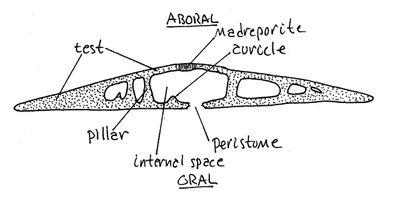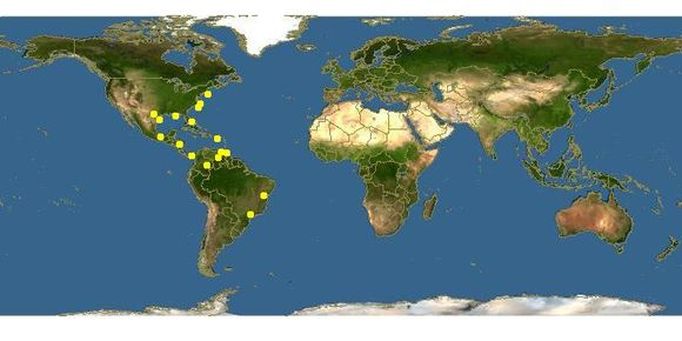 pic (3)
pic (3)
Description(2):
- Echinoderm: secondarily radially symmetric deuterostome (3)
- Coelomates (2)
- Marine and benthic (3)
- Grow to 140 mm long and 15 cm wide, smaller ones average at 75 mm
- Closely related to sea urchins
- Do not have arms, but have much shorter spines
- Their bodies are flattened with an upward slope towards the center of the aboral (top) side, but not perfectly circular in shape
- The oral (bottom) surface is usually flat or concave with the mouth directly in the center and the anus to one side
- The mouth is made up of five teeth arranged in a circle that form what is called, "Aristotle's lantern"
- Skeletons are called a test and are covered with epidermis, spines used for burrowing, tube feet for locomotion, and cilia
- On the aboral side, petalloids, specialized tube feet, are arranged in the shape of five flower petals: used as gills
- There are five oval shaped holes, called lunules, that completely pierce the tests of keyhole urchins
- There are two pairs of lunules, one pair toward the top and one large longer hole in between the second pair that are towards the bottom
- Younger keyhole urchins have notches that will later develop into the lunules
- They are colored tan, brown, and occasionally gray or greenish
Habitat(2):
- Dispersed along the east coast of the United States from Virginia heading south, surrounding the Florida peninsula, west into the Gulf of Mexico to Texas, south to Mexico, and along the coast of Brazil. Keyhole urchins are also found along the coasts of Bermuda, Jamaica, and Puerto Rico
- Found in shallow waters below tide lines in sandy bottoms
- Favors habitats where the salinity of the water is greater than twenty three parts per thousand
- Most commonly found in bay areas near inlets
Nutrition:
- The water vascular system functions in support of locomotory tube feet but is also important in gas exchange, excretion, and feeding (3)
- Omnivorous (2)
- Pull food particles from the sand with their tube feet which are then guided toward the mouth by cilia and mucous (2)
- Feed on microorganisms, algae, marine plants and shellfish (2)
Reproduction(2):
- The life cycles of keyhole urchins are complex and pass through several stages of metamorphosis.
- After the eggs have been fertilized they will develop into swimming larvae that are bilaterally symmetrical
- The swimming larvae are covered with cilia, drift about the sea water as plankton for four to six weeks, and feed on tiny organisms until they develop into young keyhole urchins that will grow into adults on the ocean floor
- The young keyhole urchins eat sand and store it in their gut to weigh them down while developing into adults
- Adult keyhole urchins are radially symmetrical
- Breed annually from the late spring into the summer months
- Reproduce sexually by external fertilization: millions of eggs and sperm are released into the water where fertilization occurs
- Are also capable of regeneration of spines and areas of their test
Interesting facts(2):
- They control the populations of many small organisms by mass producing their gametes that the other organism eat
- They often disturb several layers of sediment by sifting for food and burrowing

